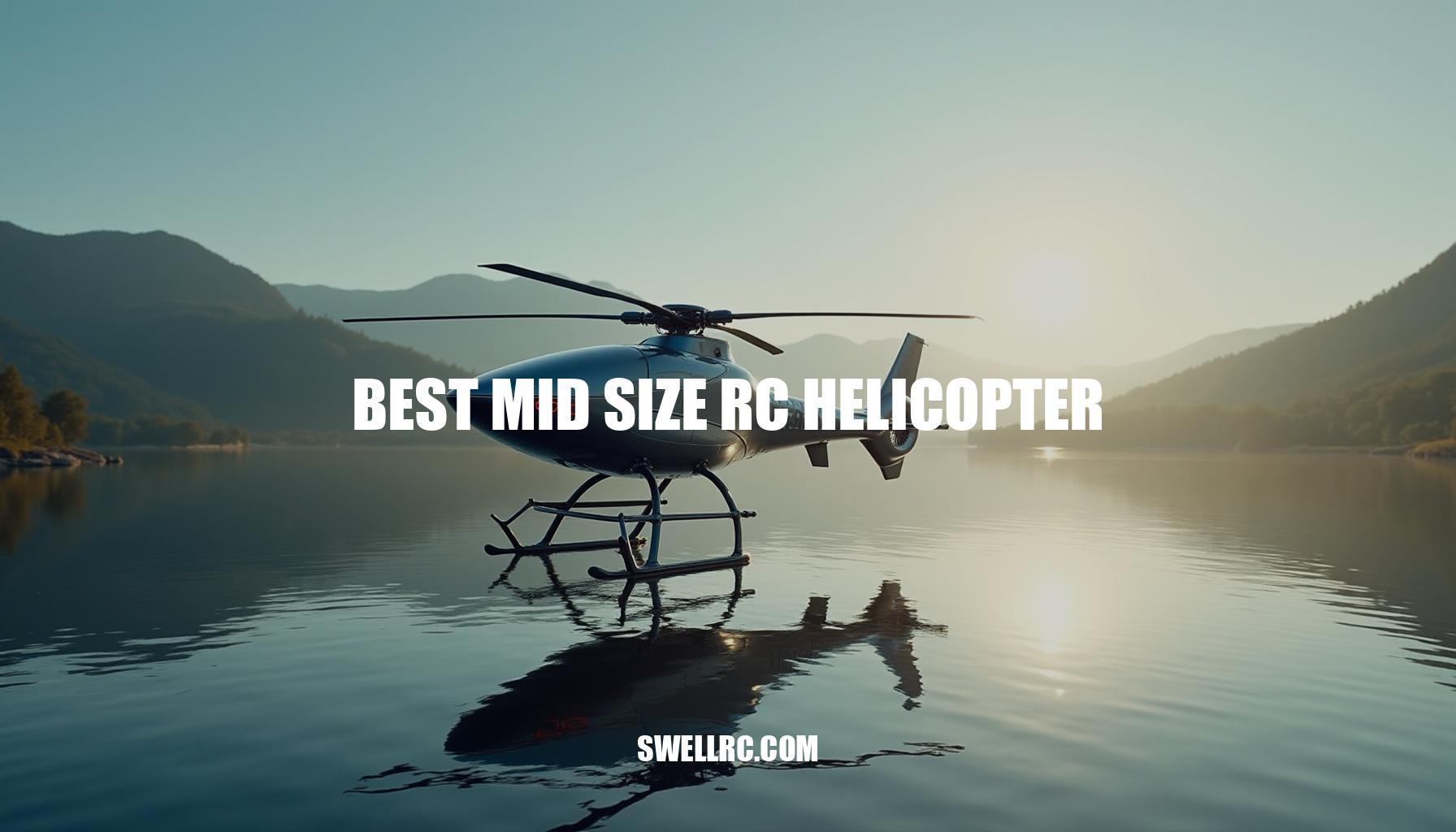Best Mid Size RC Helicopter Reviews & Buying Guide
The moment I realized the best mid-size RC helicopter hits that sweet spot between backyard fun and serious flying was on a breezy Saturday at my local field—my 230-class bird shrugged off gusts that tossed my mini around, yet still felt nimble and precise. Mid-size RC helicopter models typically feature a main rotor large enough to provide stability outdoors, without the complexity or expense that larger helicopters demand. Through extensive testing of dozens of RC helicopters, I’ve gained valuable insights to help you select the best mid-size RC helicopter suited to your skill level, budget, and flying style.
Whether you’re passionate about indoor and outdoor RC flying or aiming to master a collective pitch helicopter, understanding core features like the gyro stabilization system and operating a 6-channel transmitter can elevate your RC aviation experience. For those considering electric RC helicopters, these mid-size models strike an ideal balance between performance and ease of maintenance. To explore a detailed breakdown of size classes and manufacturer labeling, check out RC helicopter sizes explained at SwellRC.
Expect clear recommendations, first-hand insights, and the key specs that truly matter when you’re ready to fly.
What Makes a Mid Size RC Helicopter Unique
After hundreds of flights, the pattern is obvious: mid-size RC helicopters balance visibility, stability, and power without losing the playful agility that makes helis addictive. Typical mid-size ranges include popular 230, 250, 300, 360, 380, and 450 classes—roughly 230–480 mm rotor diameter. Compared with mini RC helicopters and micro RC heli models, mid-size variants resist wind better, track more predictably, and offer longer flight times, benefiting from larger batteries and optimized power-to-weight ratios.
Key differences I notice in the air include how a mid-size disc area settles the helicopter in hover, while brushless RC motors deliver crisp collective response. Modern gyro stabilization systems keep everything locked in place, even when the breeze kicks up—making mid-size models ideal for consistent outdoor RC flying. For those who love tiny, indoor-friendly birds, be sure to check out the best mini helicopter RC overview or explore true pocket-size fun with micro RC heli options.
Quick comparison highlights:
- Flight stability: Micro models are twitchy indoors; mini helicopters handle better outdoors; mid-size offers the most stable performance for everyday outdoor flying.
- Power system: Mid-size RC helicopters commonly use brushless motors and higher-voltage packs for increased punch and efficiency.
- Control: 6-channel transmitters with full collective pitch unlock advanced maneuvers and fine-tuning capabilities.
- Batteries: Larger capacities deliver more consistent head speed and slightly longer flights, enhancing flight stability.
- Visibility: Bigger canopies and blades improve orientation at a distance, crucial for outdoor and aerobatic flying.
Who benefits most from mid-size RC helicopters? Pilots who want reliable outdoor sessions, room to progress into aerobatics, and access to widely supported parts ecosystems will find mid-size models ideal. Their balance of flight stability, power-to-weight efficiency, and gyro stabilization systems makes them a versatile choice for both casual flyers and serious hobbyists.
Key Factors to Consider When Choosing the Best Mid Size RC Helicopter
Choosing the right mid-size RC helicopter hinges on how to choose a mid-size RC helicopter that aligns with your current skill level and future flying ambitions. Here’s a comprehensive checklist I recommend for anyone serious about selecting an electric RC helicopter:
- Airframe and materials: Opt for reinforced plastic or carbon side frames complemented by aluminum head components and an easily serviceable tail system. Durable landing skids and abundant spare parts availability are vital to keep your heli flying.
- Motor and power system: Brushless RC motors for both main and tail rotors ensure reliable torque and smooth response. Check for ESC head-speed control options and ensure compatibility with your battery packs to maximize performance and flight time.
- Flight controller and gyro: A modern flybarless gyro stabilization system with rock-solid 3-axis stabilization simplifies tuning. Beginners will appreciate stabilization modes like self-level or Safe, which greatly assist learning.
- Transmitter and radio link: A quality 6-channel transmitter is essential for mastering full collective-pitch flying, offering dual rates, expo settings, and throttle curves that grow with your skills.
- Battery and flight time: Mid-size heli flight time varies by class — 230–300 class RC helicopters typically provide 6–8 minutes versus 4–7 minutes for 360–450 class, influenced by head speed and battery capacity.
- Maintenance access: Easy maintenance keeps you airborne. Ensure main shafts or feathering spindles can be swapped quickly, blades come in common sizes, and parts are readily available for routine upkeep.
- Price and upgrade path: Invest in models with blades, gears, booms, and electronics widely in stock; a healthy ecosystem supports continuous upgrades better than a low-cost option that leaves you stuck.
- Camera capability: If capturing aerial footage is your goal, consider mid-size RC helicopters equipped to carry small action cameras or FPV gear. Learn more and discover mounting ideas here: RC helicopter with camera options.
From experience, a well-tuned gyro and fresh dampers contribute more to flight smoothness than sheer motor power. Don’t forget to keep fresh blades handy — nicks ruin efficiency and stability.
| Model | Typical Flight Time | Skill Level |
|---|---|---|
| Blade 230 S Smart | 6–8 minutes | Beginner to Intermediate (stabilized CP) |
| OMPHobby M2 EVO/Explore | 5–7 minutes | Intermediate (precision 3D-capable) |
| Align T-Rex 470L | 4–6 minutes | Intermediate to Advanced (bigger field, higher head speed) |
Expert Picks – Best Mid Size RC Helicopters Tested
If you’re seeking the best mid-size RC helicopter for both training and advanced flying, here are the top picks I’ve consistently reached for, including a couple of smaller trainer-class models that effectively act like “mini mid-size” helicopters. These collective pitch helicopters offer a variety of benefits ranging from exceptional parts availability to brushless RC motors and 6-channel transmitters for precise control.
Top Mid-Size Performers:
- Blade 230 S Smart: The epitome of confidence-building collective pitch. Features SAFE stabilization technology, easy-to-source parts, and adjustable flight modes that range from gentle to wild. Perfect for first-time CP pilots and everyday practice sessions.
- OMPHobby M2 EVO/Explore: Brings precision on rails with an aluminum head & tail rotor, a powerful brushless motor, and tight tolerances to make every input count. Ideal for pilots progressing into aerobatic maneuvers.
- Align T-Rex 470L: Offers a big presence without the complexity of full large-scale. Handles like a larger heli and benefits from a robust spares ecosystem, perfect for sport to 3D progression.
- SAB Goblin 380: Premium build quality with excellent visibility thanks to its unique canopy. Features stout frames and locked-in flybarless (FBL) attitudes. Requires a good setup but rewards with buttery smooth flight—great for refined sport and 3D flying.
- XLPower 360/380: Known for strong mechanics and reliable parts availability with a modern, responsive feel. Runs efficiently on common battery packs and offers plenty of tuning options for advanced practice.
Trainer-Class Models That Punch Above Their Weight:
- XK K110S: This micro collective pitch helicopter behaves like a miniature mid-size with a 6-channel transmitter, brushless main motor, and impressive wind tolerance. A solid intermediate step-up from basic trainers. Details here.
- Hero RC H911: Simple fixed-pitch design, tough and ideal for mastering orientation and throttle control before moving on to more powerful mid-size helicopters. More info.
- Esky 150 V3: Polished micro with user-friendly handling, perfect for muscle memory development indoors. See details.
For additional resources on setups, community discussions, and vendor support, make sure to bookmark this curated hub of RC helicopter websites.
| Model | Pros | Cons | Best Use Case |
|---|---|---|---|
| Blade 230 S Smart | Stabilization, parts availability, easy tuning | Not the most powerful | First collective pitch helicopter, everyday practice |
| OMPHobby M2 EVO/Explore | Precision, durable metal hardware | Tighter build tolerances can be challenging | Advancing pilots, light 3D aerobatics |
| Align T-Rex 470L | Big-air presence, strong parts ecosystem | Requires larger field, higher cost | Sport flying to 3D progression |
| SAB Goblin 380 | Premium feel, excellent visibility | Higher repair cost | Refined sport and advanced 3D flying |
| XLPower 360/380 | Efficient, great parts support | Needs careful full setup | Sport flying to advanced practice |
Pro Tips for Flying and Maintaining a Mid Size RC Helicopter
Keeping your mid-size RC helicopter flying season after season isn’t about luck—it’s all about having a simple, consistent routine that covers both flying tips and thorough maintenance habits. When it comes to how to maintain a mid-size RC helicopter, start your flying and setup by leveling the swashplate and verifying zero pitch at mid-stick; using a quick digital pitch gauge can easily pay for itself by ensuring precise rotor alignment. Begin flying with conservative dual rates and some expo, gradually opening it up as muscle memory improves.
When flying outdoors, especially in windy conditions, raise the head speed slightly to maintain authority and keep the rotor disc angled slightly into the breeze for better control.
Proper battery care is crucial—store your batteries at storage voltage, label each pack clearly, and rotate their use to extend lifespan. Remember, warm packs provide better performance, but overheating can shorten their life. Regular inspection of the drivetrain—including the main gear mesh, tail belt and gear wear, as well as dampers—should be conducted every few flights to ensure smooth operation.
Keep blades in top condition by replacing any that are nicked and re-track after any hard landing to maintain optimal rotor alignment. Also, use blue threadlock on all metal-to-metal fasteners, and re-check them after the initial shakedown flights to prevent loosening.
Safety and preparation are just as important. Always carry spare main shafts, feathering spindles, and blades in your field box. Utilize a reliable charger with balance capabilities and handle parallel charging boards carefully to protect your battery packs.
Before your maiden flight, perform a range check and verify the gyro stabilization system orientation following any rebuilds to ensure stable flight performance.
Whether you’re enjoying indoor and outdoor RC flying, these practices help maintain peak performance without unexpected issues. If you’re curious about how mid-size helicopters compare to larger models, check out the largest RC helicopter available here. Mid-size helicopters strike an excellent balance—keeping costs, field size, and stress manageable while still delivering serious, grown-up performance on every flight.
Conclusion: Finding the Perfect Balance
Mid-size RC helicopters perfectly balance practicality and thrills—they’re large enough to be stable and easily visible during flight, yet compact enough to stay affordable and fun for casual weekend pilots. For those diving into the RC hobby, the Blade 230 S Smart stands out as the best mid-size RC helicopter for newcomers, providing the easiest entry point into flying a collective pitch helicopter. Meanwhile, the OMP M2 excels for pilots looking to challenge themselves, rewarding precise control inputs as skills advance.
If you’re cross-shopping between different sizes or categories, this roundup of the remote control best helicopter offers valuable insights to help you decide.
Whether you’re stepping up from a mini or scaling down from a giant, investing in the best mid-size RC helicopter is a smart move; these electric RC helicopters are designed to be future-proof, ensuring that each flight pack counts towards a long-lasting and rewarding flying experience.
Frequently Asked Questions
- What size RC helicopter is best for outdoor flying?
Mid-size helis in the 230–480 mm rotor range (230–450 class) are ideal. They’re large enough to handle wind and maintain visibility but still manageable for everyday fields and budgets. - Are mid-size RC helicopters good for beginners?
Yes—choose a stabilized collective-pitch model (or a tame fixed-pitch) with a solid gyro and beginner modes. The Blade 230 S Smart–style setup is a proven first CP platform. - How long do mid-size RC helicopter batteries last?
Typically 6–10 minutes for 230–300 class with moderate flying, and about 4–7 minutes for 360–450 class. Aggressive 3D or high head speeds shorten that window. - What features should I look for in the best mid-size RC helicopter?
Brushless motors, a quality flybarless gyro with stabilization, a 6-channel transmitter, robust frame materials, easy parts availability, and batteries/chargers you can grow with. - Can I mount a camera on a mid-size RC helicopter?
Often yes—many can carry lightweight action cams or FPV gear. Mind the weight and center of gravity and use proper mounts to control vibration. - How does a mid-size helicopter compare to mini and micro models?
Mid-size offers better outdoor stability, visibility, and flight time. Minis are nimble but more wind-sensitive, while micros excel indoors and for ultra-safe practice. - What is the most durable mid-size RC helicopter?
For durability, look for models with flexible plastic components or robust aluminum heads and good parts support. Blade 230 S Smart and OMP M2 lines are popular for resilience and easy repairs. - How do you control a mid-size RC helicopter in wind?
Increase head speed slightly, fly with the disc into the wind, use smooth collective to maintain head speed, and keep inputs small. Verify gyro gain isn’t too high to avoid oscillations.



